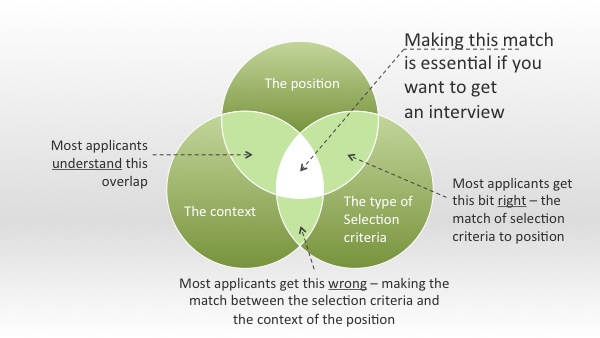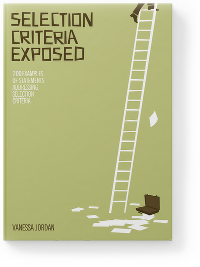Addressing Selection Criteria in 3 Steps

Addressing selection criteria for a government job is a confusing process that often appears to be shrouded in mystery unless you are already a government employee.
Websites and guides that provide advice usually gloss over what's required and are sometimes outright inaccurate. Examples that are provided are lacking in depth, complexity and length.
As a government recruiter, I see countless job applications that are lacking (note, it is usually the written applications that are lacking in content not the applicants that are lacking in skills) simply because people do not know how to address selection criteria.
In this article, I will outline three steps that I recommend following when writing selection criteria.
Most people start at step three, skipping straight to the drafting stage. But, if you put a little time into steps one and two, can make a world of difference to your finished product.
If you are seriously short on time or you are revising what you've already written, skip down to the 'Identifying the Type of Selection Criteria you are Addressing' section under step two.
Steps to Addressing Selection Criteria:
Step 1 - Investigate the position and how to apply.
Step 2 - Plan and pre-write your selection criteria.
Step 3 - Draft and refine your selection criteria responses.
(Bonus step 4 - Use our free examples).
Read below for these steps in detail!
Step 1 -
Investigate The Position and How to Apply
This stage involves:
-
Researching the position.
Once you’ve decided to take the plunge, before you start writing your application, it is important to find out as much information as you can about the position, the company, and the industry.
As an applicant, you need to be able to demonstrate that you are better able to satisfy the requirements of the position than any other applicant. Therefore, you are better positioned if you invest time into researching the government department, the area the position is located in, and the actual position so that you can frame your application to their needs.
Read more about why you should research a position and how to do it.
-
Find out what is required in your application.
What do you need to include in your application? How long does it have to be? Are there any selection criteria or targeted questions to answer? Do you need to include a resume? Or written reference checks?
-
Deciding if you want to invest the time applying.
A government job application requires a significant time investment compared to an application for a job in the private industry, so you should be sure this is a job you want to apply for (before you get halfway through your application and change your mind!)
-
Speaking to the contact officer.
A lot of applicants feel awkward or embarrassed about ringing the contact officer listed on a job ad. But, successful applications almost always have one thing in common, and this is that they rang the contact officer, had a chat about the position and got some additional information to help when addressing their selection criteria.
A list of questions you can ask the contact officer is here.
Step 2 - Plan and Pre-write Your Selection Criteria
The planning and pre-writing stage involves:
A. Identify the type of
selection criteria you are addressing (see below).
B. Put the
selection criteria into context (see below).
C. Pinpoint the skills you have that are relevant to the position.
D. Brainstorm some actual examples of
your skills in action (see below).
A. Identify the Type of Selection Criteria you are Addressing
Know what kind of selection criteria you are addressing will help you frame your statements.
The selection criteria could be:
1. Skills and abilities
2. Knowledge
3. Experience
4. Qualifications
5. Work-related qualities

Each type of selection criteria has its own requirements and should be answered according to its type.

B. Put the Selection Criteria into Context
What does this mean?
It means understanding why the selection criteria are important in this particular job.
For example, the type
of communication skills required for a
Customer Service Officer versus a Chief Finance Officer will be very
different.
A different level of
complexity exists because these roles will be
operating at significantly different levels in the hierarchy, and
secondly, these roles will be communicating with different people,
about different things, in different contexts and by different means.
To put the criteria into context, you will use the job description or duty statement to point you in the right direction. If you own the ebook The Selection Criteria Coach there are worksheets inside that will help you do this.
C. Identify the Skills you Have That are Relevant to the Position
This is the part the job applicants often find the hardest. We have lists and templates to help with this in our book The Selection Criteria Coach.
You could also create your own simple worksheet such as the one below. A sheet like this can also be used for the next step when brainstorming examples.
(If the column headings are difficult to read, they are column 1: selection criteria - column 2: duties / criteria keywords - column 3: my examples).

D. Brainstorm Examples for Your Selection Criteria
Brainstorming ideas and examples of things to write about in advance is a lot easier than writing on the fly. It will make your statements easier to structure in advance, and with all the planning processes, make your statements quicker to write and more effective in the long run.
Your brainstorming list should include examples of your actual skills in action and be related to the position (that you have discovered in step 1 above), the type of selection criteria (outlined in step 2 above), and the context of the selection criteria.

Step 3 - Draft and Refine
The drafting and refining stages includes:
- Writing your first draft.
- Editing your first draft.
- Having someone else read over your work.
Writing Your Selection Criteria Response Draft
Writing selection criteria is a lot like writing an essay (remember those?)
Your document will need to have a beginning (introduction), a middle (the body) and an end (the conclusion). Just like with a high school essay, the body is going to be the most important part because it is where you provide evidence for your argument. (And of course, your argument is that you are the best person for the job!)
Selection criteria as a general rule are inescapably full of three
things:
1. Facts
2. Opinions
3. Inferences
Most statements addressing selection criteria contain a lot of
inferences (make a blanket statement and leave the selection panel to
read between the lines or put the dots together), a moderate amount of
opinions (sentences or paragraphs without any evidence to back them up,
or someone’s general knowledge), and few facts.
Good statements addressing selection criteria are the exact opposite.
They have lots of facts and barely any opinions or inferences. The best
way to pack your statements addressing the selection criteria with
facts, is to give solid examples and include measures of success and
data if you can.
Addressing Selection Criteria Example
For example, a person applying for a Project Manager position in the APS, with
a middle management salary, that is required to work autonomously and
with little supervision, would write a prioritising selection criteria
like this:
"The ability to prioritise your own work"
My current position as project reporter is extremely autonomous. I am responsible for identifying projects in the organisation that have specific reporting needs and completing project reports on an independent basis. I am faced with tight time frames to complete these exercises, write the reports and submit to relevant delegates, and I work without supervision. This position requires high-level organisational skills, and I regularly use my strong negotiation skills to discuss with different work areas regarding competing priorities. I currently spend half of my working hours in an office and the other half consulting at various sites around Queensland. This requires forward planning abilities, excellent time management skills and a solid work ethic. All these tasks required different time inputs with varying and often conflicting deadlines. In addition, I reported to different people for most of these tasks and have found over the past four years in this role that I have gained exceptional skills in balancing different managers and stakeholders who invariably all want my attention at the same time. I think my excellent organisational and negotiation skills have made it possible to juggle these priorities and keep all parties satisfied that their task has my full attention.
Because I often work on up to four projects at one time, I use a variety of tools to prioritise and organise my work and schedule my time. I use a mobile diary and task list, and I have authored an Access database and Excel spreadsheet to assist with tracking projects. The Access database contains details of each individual reporting project and the Excel spreadsheet is used as a timesheet so that I can track my daily hours against each project. Although these are simple tools, the accuracy of the information contained is crucial for tracking productivity information and reporting against personal and team key performance indicators. I have found that embracing IT tools has reduced the time needed for general administration, allowing me to concentrate on the work at hand.
I have the ability to prioritise tasks and continually reassess workflows and priorities in a busy and demanding environment. These skills are also demonstrated in my previous role as project officer where I organised my work between:
You will notice that the applicant has provided actual examples of
what they have done and what they have achieved in the context of the
position that they are applying for.
Making
this match is essential if you want to make an impression and get an
interview.
Editing
All three stages are really important. I have seen selection panel members put applications in the 'no pile' simply because someone has had a couple of spelling errors in their selection criteria statements and this has reflected poorly on their written communication skills. A proof read, or having someone else read the application before hand would have meant this person probably would have gotten an interview.
Selection Criteria Examples
Our free sample of the ebook Selection Criteria Exposed contains free selection criteria examples that you can download right now.

More Help With Your Job Application:
 How to write better selection criteria
How to write better selection criteria How to research an organisation
How to research an organisation Dealing with selection criteria that you don't meet
Dealing with selection criteria that you don't meet
